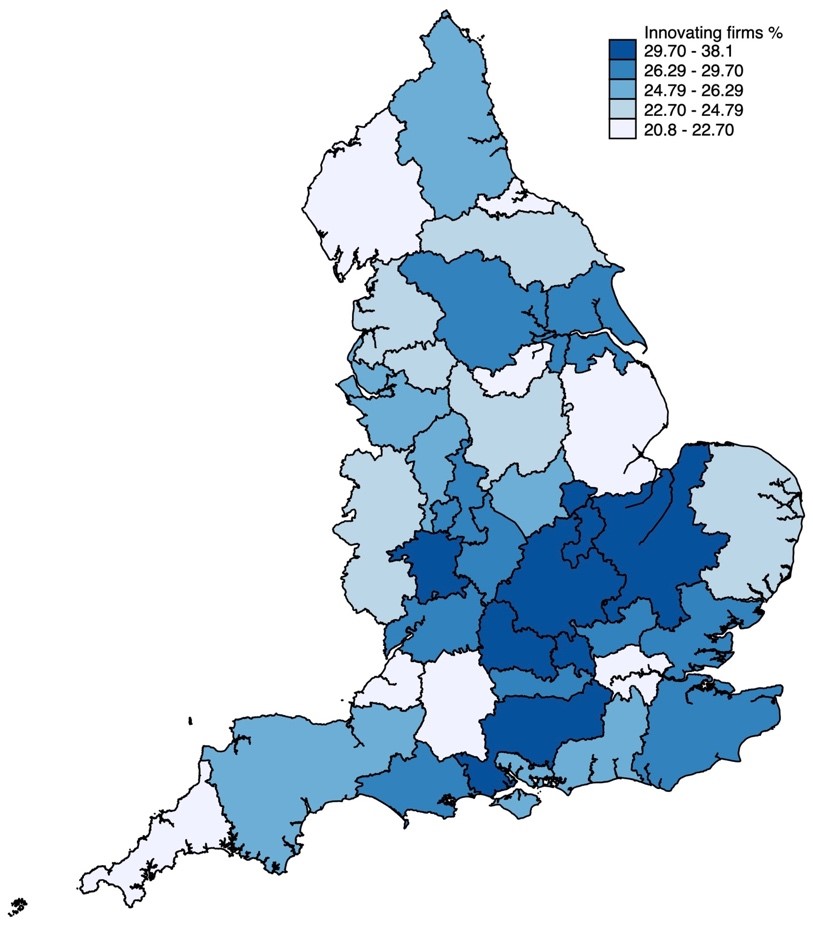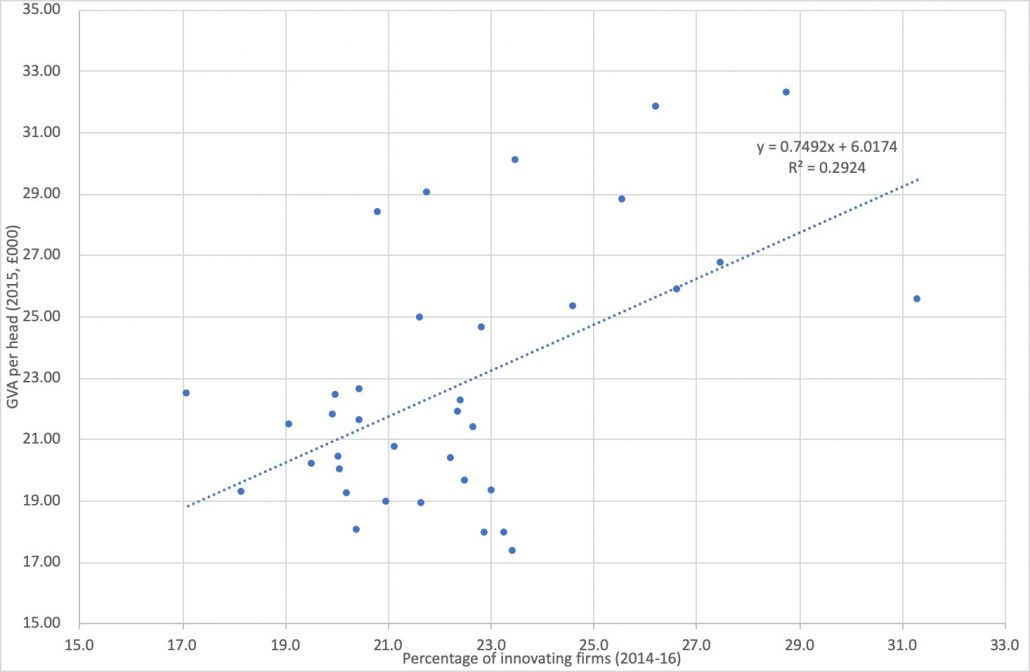Innovation and productivity: How strong is the connection?
Innovation and productivity: How strong is the connection?
‘Innovation’ is a much used (and abused) term employed to describe everything from flea collars for dogs[1] to electric cars. As a result, measuring innovation can be tricky, particularly in service sectors where firms’ relationships to customers are often individual and bespoke.
Fortunately, the kind people at the Organisation for Economic Cooperation and Development (OECD) have developed rules for what is an isn’t an innovation. In their terms, an innovation is ‘a new good or service or a significantly improved good or service with respect to its capabilities, such as quality, user friendliness, software or subsystems’. This definition is used globally to measure firms’ innovation activity and benchmark countries and local areas.
Applying this definition to local areas in England using the most recent data available from the UK Innovation Survey (for 2014-16) suggests that levels of innovation vary significantly between areas. The most innovative areas form an arc North of the M25 and including Oxfordshire, the South East Midlands and Greater Cambridge & Peterborough. By contrast, more rural and peripheral areas of England – Cumbria, the North East, Cornwall – tend to have lower levels of innovation. The differences between areas can be quite stark with 38 per cent of firms in Buckinghamshire-Thames Valley reporting innovation compared to only 21 per cent in Cumbria and Lincolnshire. This local geography of innovation has also been pretty consistent over recent years – the more innovative areas have tended to retain their lead.
Figure 1: Percentage of innovating firms: Local Enterprise Partnership areas in England
At national level the proportion of firms introducing product or service innovations has increased slightly in recent years – from 20.6 per cent in 2012-14 to 23.9 per cent in 2014-16. The proportion of firms introducing process innovations fell marginally over the same period, however, to 16.9 per cent as did the proportion of firms making strategic or organisational changes such as the implementation of quality management or lean production[2].
But does this matter in terms of broader economic impact? Are these levels of innovation related to productivity or other indicators of prosperity? Surprisingly, at the level of individual firm, the link between innovation and firm profitability or growth is often difficult to prove. Often new innovations – products or services – may take some time to influence firms’ bottom line and many innovations are unsuccessful when they are introduced. Many other factors also influence firms’ performance, so the link from innovation to firms’ bottom line is often difficult to demonstrate conclusively.
What about the link between innovation and productivity for local areas? Well, Figure 2 tells the story for local areas in England. The chart relates innovation from 2014-16 on the horizontal axis to productivity (GVA per head, 2015) on the vertical axis. Each point represents a LEP area in England, although two local areas with particularly high levels of productivity – London and Thames Valley-Berkshire – are excluded from the graph. A crude curve fitted through the other points suggests that a 1 per cent increase in the percentage of innovating firms is associated with an increase of £749 pa in GVA per person.
Figure 2: Innovation and productivity by local area in England
Notes and sources: Innovation data from ERC (2019). GVA per employee data from https://www.ons.gov.uk/economy/grossvalueaddedgva/datasets/gvaforlocalenterprisepartnerships
The diversity of innovation performance across local areas in England illustrated in Figure 1 provides a challenging context for the Local Enterprise Partnerships as they develop and implement their Local Industrial Strategies. For some areas the innovation challenge is sustaining their leadership position. For other areas where levels of innovation activity are lower, there is perhaps more to gain from prioritising the development of innovation capabilities. In either case, its clear that local innovation matters. And, support is available through R&D tax credits as well as through competitive funding from Innovate UK.
Stephen Roper
Please note that the views expressed in this blog belong to the individual blogger and do not represent the official view of
the Enterprise Research Centre, its Funders or Advisory Group.
[1] https://www.petbasics.com/education/compare-flea-products/
[2] Source: UK innovation survey 2014-16 statistical annex, Table 14. Available at: https://www.gov.uk/government/statistics/uk-innovation-survey-2017-main-report













